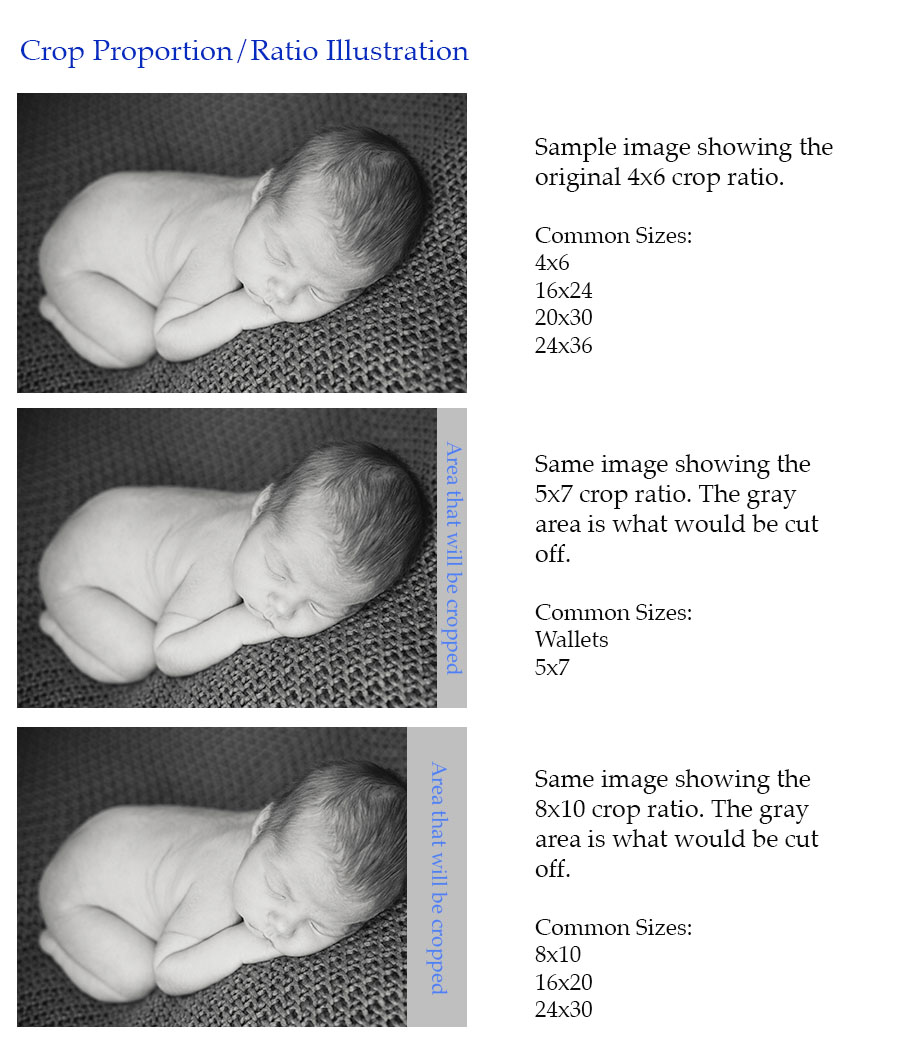I’ve gotten this question a lot recently, so I thought it would be helpful to dedicate a page to the topic to help clarify for you, my clients, and the entire interweb.
The terms “crop proportions” and “image resolution” are two separate concepts, but are often confused or thought of as one in the same.
Here’s the difference:
Crop Proportion/Ratio refers to the ratio of the height and width of a photo, or the physical size of the print. For example, a 4×6 crop proportion is the same proportion as 8×12, 16×24 or 20×30. I know you didn’t come here for a math lesson, but surprisingly, there’s a lot of math involved in the art of photography.
Image Resolution refers to the number of pixels per inch or dots per inch (dpi). The greater the dpi, the greater the detail and print quality of the photo. This dpi value is what will determine the quality of the print.
Print Quality vs. Web Quality
The industry standard for high quality print resolution is 300 dpi. Images captured at this resolution will have a larger file size. For jpegs, they will be in the neighborhood of 8 to 15 megabytes per image. A file size this large is not good for posting to the web because it will take forever to load when a page is refreshed. For this reason, the recommended resolution size for web images is 72 dpi. These images are usually less than 500 kilobytes in size because it saves fewer individual pixels and takes less space.
When you order a print from me, you will always receive a high resolution print quality image of 300 dpi. The same can be said for the digital images that you purchase from me. They will all be high quality 300 dpi. The version of the images that I post online for web sharing are all of lower resolution, and that is done on purpose to help web pages load more quickly. Images posted online are not meant to be printed, one because it’s illegal and a copyright infringement unless the print rights have been purchased from me, and two because the resolution is lower and these images cannot be enlarged without drastically degrading the quality of the image.
Most cameras capture the image in a 2:3 proportion, and I compose all of my images in that same proportion. If the photo size you want to have printed is a 5×7 or an 8×10, which are both very common print sizes, part of the image will need to be “cropped” or cut off. The image quality, or dpi, will remain the same, but part of the image will need to physically be cropped off by the print lab. Some photo composition will allow for this just fine, while others might not lend for certain crop proportions as well, and will cut off part of the image.
Let’s take the 4×6 example. When the image is composed in this proportion, if you would like an 8×10 photo of that image, cropping will occur. Why? Because 8×10 is not divisible by 4×6. The short side won’t be cropped at all, because 8 is divisible by 4. But the long edge will be cropped by 2 inches because when you increase the size of the 4×6 by 2, you’ll end up with an 8×12. So to get down to the desired 8×10 in size, the only way to do that is to cut off the extra 2 inches on the long edge of the photo.
If the image started out being a “tight” shot, meaning close up (like the newborn pose in the graphic shown below), only certain print sizes will lend themselves well. I won’t get into the rule of thirds here, but I along with every other photographer compose their images with a purpose and a vision in mind.
Let’s illustrate this with pictures….and I’m sure at this point you’re saying, it’s about time. Words just don’t do this topic near the justice as pictures can.
You can see in the different photos above. The first one is the crop that I have intended for the image. The second image shows the 5×7 crop ratio, and while the baby is still entirely in the photo, the right side is very close to his head, and when you frame that image, part of his head would be hidden by the edge of the frame. Then we get to the final photo in the 8×10 crop ratio (I am not a fan of the 8×10 crop ratio in general), and clearly the clipping that occurs cuts off part of the baby’s head in this image and ruins the print in my estimation.
I didn’t include all of the different crop sizes like 11×14 and the square crops, etc. But the same concept holds for every different crop ratio. We can’t just skew and stretch images to fit every size.
When you order the digital negatives from me, you’re paying for the images with print rights in a 4×6 crop ratio. If you would like to print your own photos in a crop ratio different than the 4×6, then it will be up to you to crop them accordingly, and I can’t guarantee that every photo will lend itself well for all the different crop ratios you have in mind. I try to leave enough “dead space” on the edges of the images to allow for some different cropping in the lab that you choose, but I will also have some photos that are composed as a tight shot on the subject because I think it looks the best.
However, when you order the physical prints from me and my print lab, you’re paying for the print itself as well as my time and effort to custom crop every one of the images you order from me in the size and ratio you desire. And I will guarantee that the image is composed within the print properly.
I hope this clears up some of the confusion around the difference between crop ratios and image resolution. I covered mostly the crop ratio and briefly mentioned the image resolution, but that’s because every image you purchase from me will be in high print resolution to allow you the freedom to blow them up to life size if you so desire.

